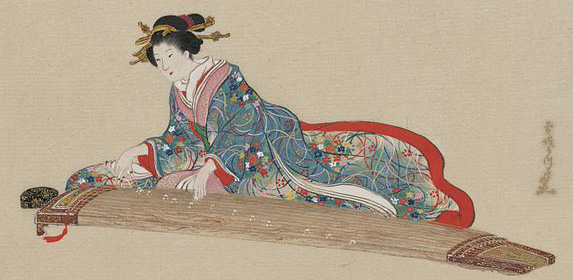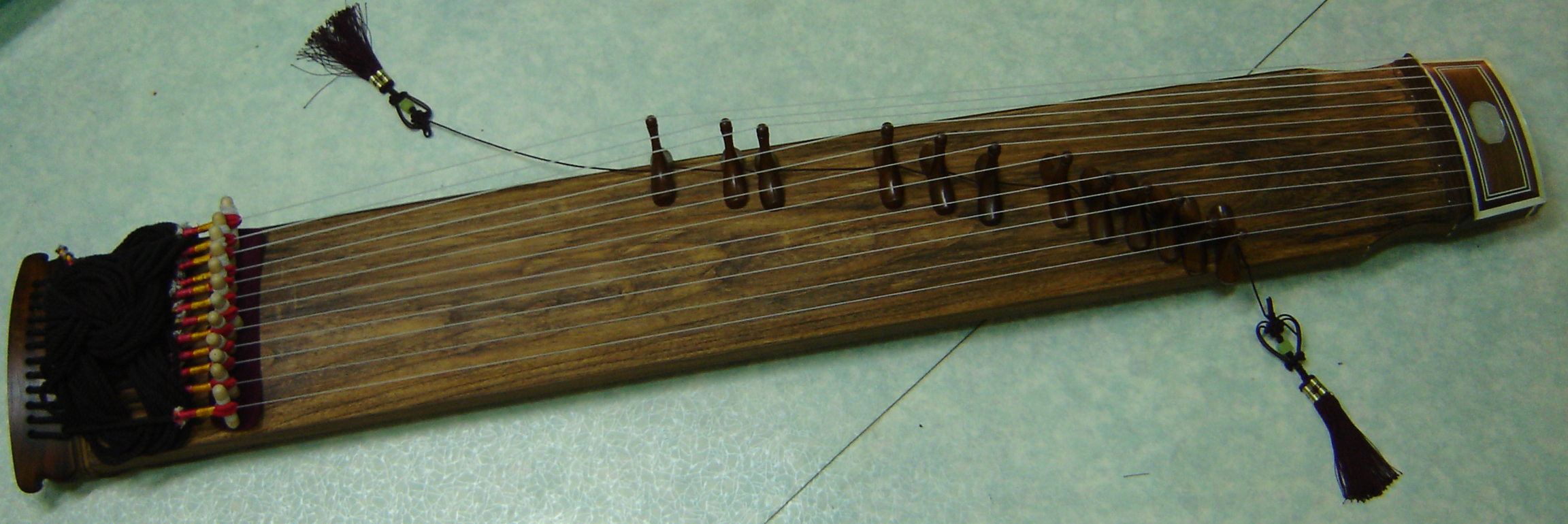彈筝 ĐÀN TRANH FAMILY
The Asian Zithers

 | |||||||||||||||||
| String | 1 | 2 | 3 | 4 | 5 | 6 | 7 | 8 | 9 | 10 | 11 | 12 | 13 | 14 | 15 | 16 | 17 |
| Pitch | E3 | G3 | A3 | C4 | D4 | E4 | G4 | A4 | C5 | D5 | E5 | G5 | A5 | C6 | D6 | E6 | G6 |
|
Characteristics of Vietnamese Music Đàn Tranh is known as Đàn Thập Lục or sixteen-stringed zither. Vietnamese music is built on melodic construction with single note colorations or melismatic — each note is an entity, called 𡨸 chữ [word], in itself. The Vietnamese musician adorns his sound with ornamentations; musician bends almost every note. Instruments always have been modified to allow for the tone-bending typical of Vietnamese music. Higher frets and looser strings are often observed. (Any given fret can produce multiple pitches. The traditional musician can get as many as four notes from a single fret.) Đàn Tranh resembles a bamboo tube that has been sliced vertically in half. Toward the middle of the sound board there are 17 bridges (called nhạn “swallows”) made of wood. At the narrower end of the box are 17 pegs (or trục) holding one end of the strings, for tuning. The strings are made of metal and tuned to a pentatonic scale. Đàn Tranh sits flat like an auto-harp and is plucked using all four fingers. Players will usually wear picks (or móng) on their fingers to facilitate plucking. Very often, Vietnamese listeners are not listening to a composition but to the interpretation of music by specific musicians. The performance's success relies mainly on how much the desired mood is built up. This is similar to the ideas of Jazz music. Improvised preludes are often played to: Improvisation of this sort is atypical of the rest of Southeast or East Asia, lending credence to the view that Vietnamese culture also exhibits traits more typical of South Asia, specifically, India. Over 2,000 years, India and Vietnam had a peaceful relationship through trading and religious expansion. Additionally, the ancient Indianized Kingdom of Champa was located on today's Vietnam territory. Other Indian influences can be found in the use of: In this way, the Vietnamese system resembles the raga system of South Asia more than anything found in East Asia. Heterophonic structure and notations The musicians in an ensemble play the same fundamental melody but add ornamentations typical of their instrument, resulting in the phonic structure called heterophonic structures which are especially common throughout much of Asia. To validate a student’s played version of beats, measures, rhythms, pitches, and ornamentations, a demanding music teacher may ask a student, “Who is your teacher?” Good teachers must therefore agree on certain conventions to preserve the character of a specific region’s music. The exact notation system used and the resultant melody vary from teacher to teacher as well as in different pieces. The repertoire is maintained entirely by memory and passed down through practice. This system of notation has no indications for the manner of performance. Many new systems of notation, invented by a few traditional masters, are being used concurrently with Western music notation. Đàn Tranh bears some likeness to the Japanese Koto (13 strings), the Korean Kayagum (12 strings), the Mongolian Jatac (12 strings), the Chinese Zeng (13-16 strings), and the Indonesian Kachap (7-24 strings). | |
| |
The Zheng the Chinese Guzheng (13-16 silk strings) (Chinese: 古箏; pinyin: gǔzhēng, pronounced [kùt͡ʂə́ŋ]), also simply called zheng (箏, gu 古 means "ancient"), is a Chinese plucked zither. It has 18 or more strings and movable bridges, and the modern guzheng usually has 21 strings and bridges. The picks (called "DaiMao") used by performers to play guzheng are often made out of the shells of hawksbill turtles. The guzheng should not be confused with the guqin (another ancient Chinese zither with no moveable bridges). | |
| |
| |
| |
 |
2471 University Avenue – Bronx – NY – 10468 Site managed by Yes We Can Music, LLC |



